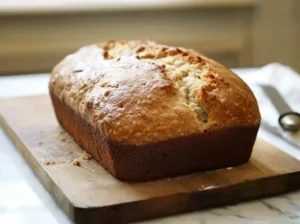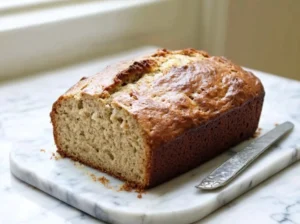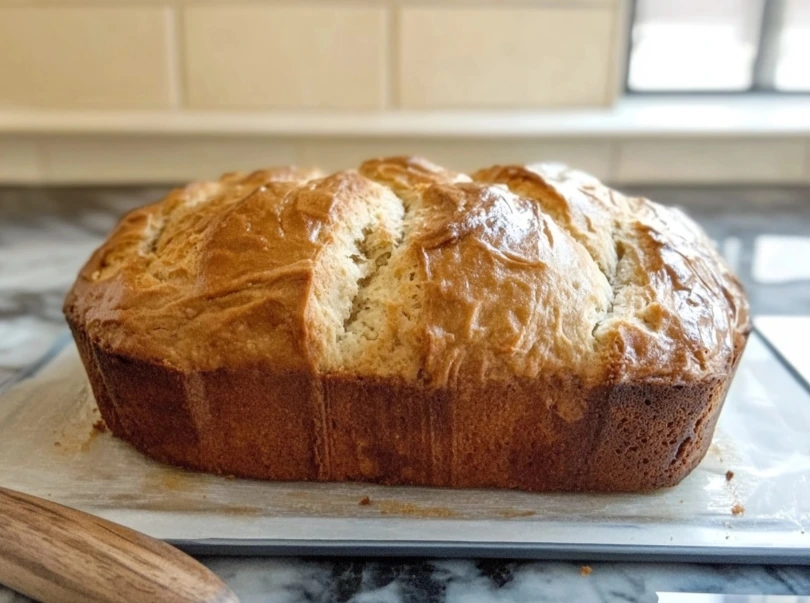Banana bread made with oil is the perfect recipe for those who love a moist and tender loaf that’s easy to make. This banana bread recipe using oil offers a simple yet delicious twist, ensuring a flavorful bake that stays fresh for days. Whether you’re looking for dairy-free options or a reliable classic, this recipe has you covered.
Why Choose Oil Over Butter in Banana Bread?
The choice between oil and butter often comes down to texture and convenience. Here’s why oil is a fantastic option for banana bread:
- Moistness: Oil creates a more moist and tender loaf compared to butter.
- Neutral Flavor: Neutral oils, like vegetable or canola, let the banana flavor shine.
- Ease of Use: No need to soften or melt—just pour and mix.
- Longer Shelf Life: Banana bread made with oil stays soft and moist for days.
Switching to oil doesn’t mean sacrificing flavor or richness. In fact, it allows the bananas and spices to take center stage.
Key Ingredients for Banana Bread Using Oil
Choosing the Right Oil for Banana Bread
The type of oil you choose can make a difference in flavor and texture. Here are some popular options:
- Vegetable Oil: A classic choice for its neutral flavor.
- Canola Oil: Light and heart-healthy, perfect for everyday baking.
- Coconut Oil: Adds a subtle, tropical sweetness, ideal if you want a unique twist.
- Olive Oil: For a more robust flavor, use light olive oil—it complements spices like cinnamon and nutmeg beautifully.
Essential Ingredients for a Moist Banana Bread
To achieve the perfect loaf, you’ll need a balance of wet and dry ingredients. Here’s what to include:
- Flour: All-purpose flour works well, but you can mix in whole wheat for added nutrition.
- Sugar: Granulated sugar for sweetness, or brown sugar for a caramel-like depth.
- Eggs: Helps bind the ingredients and adds structure.
- Bananas: The riper, the better—they add natural sweetness and flavor.
- Leavening Agents: Baking powder and baking soda for the perfect rise.
- Salt: Balances the sweetness and enhances flavors.
- Spices: Cinnamon, nutmeg, or even cardamom for a warm, aromatic touch.
- Vanilla Extract: Adds depth to the flavor profile.
Bananas: The Key to Flavor
Bananas are the heart and soul of any banana bread. Here’s how to select and prepare them:
- Ripe Bananas: Look for bananas with plenty of brown spots on the peel. The riper they are, the sweeter and more flavorful your bread will be.
- Mash Consistently: Mash bananas thoroughly to ensure an even texture throughout the loaf.
- Extra Tip: If you only have under-ripe bananas, bake them in their peels at 300°F (150°C) for 10-15 minutes to soften and sweeten.
Benefits of Using Oil in Banana Bread
Health Benefits of Oil in Baking
Using oil instead of butter in baking has several health advantages, making it an excellent choice for banana bread:
- Lower Saturated Fat: Many oils, such as canola or olive oil, are lower in saturated fats compared to butter, contributing to heart health.
- Healthy Fats: Certain oils contain unsaturated fats, which can help lower bad cholesterol levels.
- Nutritional Additions: Oils like coconut or olive can provide essential nutrients, including Vitamin E and antioxidants.
Why Oil Makes Banana Bread More Moist
Oil has unique properties that make banana bread irresistibly moist:
- Even Distribution: Unlike butter, oil blends seamlessly with the batter, locking in moisture.
- Extended Freshness: Banana bread made with oil doesn’t dry out as quickly, keeping it soft for days.
- Improved Texture: The crumb of oil-based bread is more tender and less dense, making each bite melt in your mouth.
Vegan-Friendly and Dairy-Free Options
Using oil in banana bread is a game-changer for those avoiding dairy. Here’s why:
- No Butter Required: Oil is a natural substitute, making it easy to adapt recipes for a dairy-free lifestyle.
- Vegan Adaptations: Swap eggs for flaxseed meal or applesauce, and you’ve got a completely plant-based loaf.
- Flavor Flexibility: Neutral oils like vegetable or canola are great for classic recipes, while coconut oil adds a hint of tropical richness.

How to Make Banana Bread Using Oil
Step-by-Step Instructions for Oil-Based Banana Bread
Follow these simple steps to bake the perfect loaf:
- Preheat the Oven: Set it to 350°F (175°C) and grease a loaf pan with oil or line it with parchment paper.
- Mash the Bananas: Use a fork or potato masher to mash 3-4 ripe bananas until smooth.
- Mix the Wet Ingredients: In a large bowl, whisk together the mashed bananas, ½ cup of oil, ¾ cup of sugar, 2 eggs (or substitutes), and 1 teaspoon of vanilla extract.
- Combine the Dry Ingredients: In a separate bowl, mix 1 ¾ cups of flour, 1 teaspoon of baking soda, ½ teaspoon of baking powder, ½ teaspoon of salt, and 1 teaspoon of cinnamon.
- Incorporate Wet and Dry Mixtures: Gradually fold the dry ingredients into the wet mixture, stirring gently until just combined. Avoid overmixing.
- Pour into Pan: Transfer the batter into the prepared loaf pan, spreading it evenly.
Mixing Wet and Dry Ingredients Correctly
To achieve a perfect texture, consider these tips:
- Avoid Overmixing: Stir until just combined to prevent a dense loaf.
- Check Consistency: The batter should be thick but pourable. If too dry, add a splash of milk or a dairy-free alternative.
Baking Tips for a Perfect Loaf
Ensure your banana bread turns out flawlessly with these baking tips:
- Check for Doneness: Bake for 50-60 minutes, or until a toothpick inserted into the center comes out clean.
- Cool Before Slicing: Let the bread cool in the pan for 10 minutes before transferring it to a wire rack. Wait until it’s fully cool to slice for clean cuts.
- Optional Add-Ins: Stir in nuts, chocolate chips, or dried fruit for added texture and flavor.
Choosing the Right Oil for Banana Bread
Vegetable Oil vs. Olive Oil vs. Coconut Oil
Each type of oil brings unique qualities to your banana bread. Here’s how they compare:
- Vegetable Oil: A neutral-flavored, budget-friendly option. Perfect for classic banana bread where the banana flavor takes center stage.
- Olive Oil: Use light or extra-light olive oil for a subtle, slightly fruity flavor. Avoid strong extra-virgin olive oil unless you want a robust, savory undertone.
- Coconut Oil: Adds a mild, tropical sweetness that complements bananas well. Use it melted, and note that it may solidify in cooler temperatures, requiring slight warming before use.
Flavor Considerations
The choice of oil can enhance or subtly alter the flavor of your banana bread:
- Neutral Oils (Vegetable/Canola): Best for traditional recipes or when using strong add-ins like chocolate chips or nuts.
- Coconut Oil: Ideal for tropical twists or pairing with flavors like pineapple, cinnamon, or cardamom.
- Olive Oil: Adds complexity and pairs wonderfully with spices like nutmeg or citrus zest.
How Different Oils Affect Texture
The oil you choose can influence the texture of your banana bread:
- Vegetable Oil: Produces a soft, fluffy texture with a tender crumb.
- Coconut Oil: Yields a slightly denser but still moist loaf, especially if used in cooler climates where the oil may solidify.
- Olive Oil: Creates a rich, slightly denser texture with a hint of elasticity.
Substituting Oil in Your Banana Bread Recipe
Replacing Oil with Applesauce or Yogurt
For a healthier or low-fat alternative, consider these substitutes:
- Applesauce: Replace oil in a 1:1 ratio for a lower-calorie option. This works well for moistness but may result in a slightly less rich texture.
- Greek Yogurt: Use ¾ cup of yogurt for every 1 cup of oil. Yogurt adds creaminess and a subtle tang while cutting down on fat.
When to Use a Blend of Oils
Combining oils can help balance flavor and texture:
- Coconut and Vegetable Oil: Blend for a hint of tropical sweetness without overwhelming the classic banana flavor.
- Olive and Canola Oil: Mix to achieve a light olive oil taste with the smooth consistency of canola.
- Part Oil, Part Applesauce: Use half oil and half applesauce to retain moisture while reducing fat.
Oil Substitutes for Special Diets
If you’re accommodating dietary restrictions, here are some substitutes:
- Butter Alternatives: Use melted vegan butter or plant-based spreads for a similar richness.
- Nut Butter: For a protein-packed substitute, try almond or peanut butter. Use sparingly as these can make the batter thicker.
- Avocado Oil: A healthy, neutral-flavored option, suitable for those following keto or paleo diets.

Common Mistakes to Avoid in Banana Bread Using Oil
Overmixing the Batter
One of the most common pitfalls in banana bread baking is overmixing the batter. Here’s why it matters and how to avoid it:
- The Problem: Overmixing activates the gluten in the flour, resulting in a dense and rubbery loaf instead of a light and tender one.
- The Solution: Gently fold the dry ingredients into the wet ingredients until just combined. A few small lumps are fine and will bake out.
Choosing the Wrong Type of Oil
The type of oil you use can dramatically affect the flavor and texture of your banana bread.
- The Problem: Strong-flavored oils like extra-virgin olive oil can overpower the banana flavor, while heavy oils can make the bread greasy.
- The Solution: Stick to neutral oils like vegetable, canola, or light olive oil for a classic flavor. If experimenting with stronger oils, use them sparingly or in combination with a neutral oil.
Using Too Much Oil
Adding too much oil can lead to overly greasy banana bread that doesn’t hold its shape well.
- The Problem: Excess oil can make the loaf feel heavy, overly moist, and oily to the touch.
- The Solution: Measure carefully and stick to the recipe’s recommended amount (typically ½ to ¾ cup for one loaf). If you want a lighter version, consider replacing part of the oil with applesauce or yogurt.
Frequently Asked Questions
Can I Use Olive Oil in Banana Bread?
Yes, you can use olive oil in banana bread! Light or extra-light olive oil works best because it has a milder flavor that won’t overpower the bananas. Avoid extra-virgin olive oil unless you prefer a more robust, savory undertone.
What Oil is Best for Banana Bread?
The best oil for banana bread depends on your preferences:
- Neutral Oils (Vegetable, Canola): Ideal for classic banana bread where you want the banana flavor to shine.
- Coconut Oil: Adds a subtle tropical sweetness, great for unique flavor profiles.
- Light Olive Oil: Enhances flavor and works well with spices like cinnamon or nutmeg.
Can I Freeze Banana Bread Made with Oil?
Yes, banana bread made with oil freezes beautifully. Here’s how:
- Cool Completely: Let the loaf cool to room temperature before freezing.
- Wrap Securely: Wrap tightly in plastic wrap, then place in a freezer bag or airtight container.
- Freeze: Store in the freezer for up to 3 months.
- Thaw and Serve: Thaw at room temperature or warm slices in the microwave for a freshly baked feel.
Why Do You Put Oil Instead of Butter in Bread?
Oil is used instead of butter in bread for several reasons:
- Moisture: Oil creates a softer, more tender crumb.
- Neutral Flavor: Unlike butter, oil doesn’t overshadow the banana’s natural sweetness.
- Ease of Use: No need to soften or melt—it’s ready to use straight from the bottle.
- Dairy-Free Option: Ideal for those with dietary restrictions or vegan adaptations.
Can You Substitute Oil for Bananas?
No, oil and bananas are not interchangeable because they serve different purposes.
- Bananas: Provide natural sweetness, flavor, and moisture.
- Oil: Adds richness and ensures a moist texture.
If you’re out of oil, you could replace it with another moist ingredient like applesauce or yogurt, but bananas themselves cannot directly replace oil.
Why Did My Banana Bread Not Come Out Fluffy?
A lack of fluffiness in banana bread could be due to several reasons:
- Overmixing: Activates the gluten in the flour, leading to a dense texture.
- Incorrect Leavening Agents: Too much or too little baking soda/powder affects the rise.
- Underripe Bananas: Ripe bananas are essential for adding natural moisture and sweetness.
- Oven Temperature Issues: If the oven isn’t properly preheated or set to the wrong temperature, it can affect how the bread rises.
If you’re experimenting with different ingredients in your banana bread, consider trying the banana bread with applesauce recipe for a healthier twist. For those who enjoy unique textures, the banana nut bread recipe no butter is a must-try. Alternatively, the vegan banana bread recipe provides a completely plant-based option that doesn’t compromise on flavor. And for something entirely indulgent, you can experiment with the chocolate banana cake, combining the sweetness of bananas with the richness of chocolate.
Conclusion
Banana bread made with oil is a versatile, moist, and flavorful treat that caters to a variety of dietary preferences and baking styles. By choosing the right type of oil, avoiding common mistakes, and experimenting with creative variations, you can elevate this classic recipe to new heights. Whether you prefer a traditional loaf, a dairy-free alternative, or an adventurous twist, banana bread offers endless possibilities to suit your taste. Happy baking!


1 thought on “Banana bread recipe using oil”